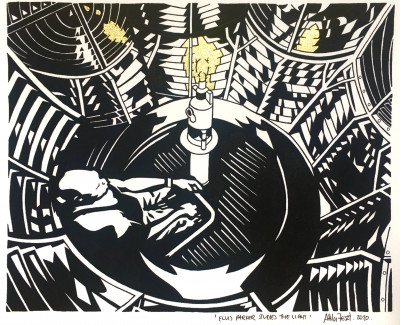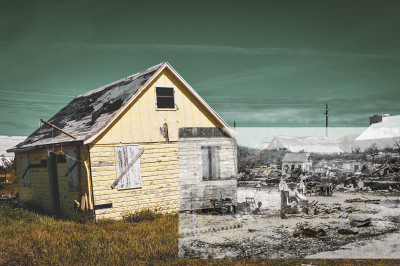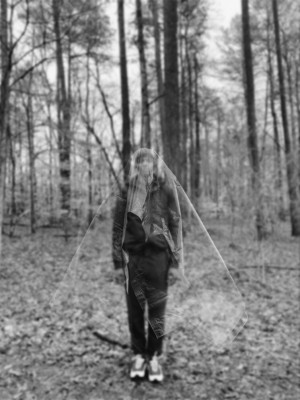A Burning for Home
09/01/2020-10/30/2020
We are delighted to present our current exhibition digitally at
www.burningforhome.com You
can also follow The D'Aguilar Art Foundation on Instagram
and Facebook for content on the exhibition. Please email us at
daf_art_events@yahoo.com if you would like to see the exhibition in person.
My heart was burning for home - Michael Anthony, The Year in San Fernando
We learn to bend and break at home. We learn to be taken care of and to care for. We learn the importance and expression of love. For many, in The Bahamas home is tied to land, a specific place, an island where generations of ancestors walked the same land, or where we’ve moved and found a sense of belonging. In both utterances of home, we deem it indestructible with no concept of its fragility. In the exhibition, A Burning for Home, artist navigate the range of emotions manifested as a result of the destruction of Hurricane Dorian on The Abacos, a collection of islands in The Bahamas, September 1st, 2019. The works in this show delve deep into the memory of the individuals, and land as the artist explore the definition of home. Each artist navigates unique emotions tied to home to bring forth a full spectrum that reflects the multidimensional nature of the home. There is grief, hope, awe, protection, consistency, and resilience. The collective work invites you into a very specific rememorying of the various places and people of The Abacos. In conjunction, the D’Aguilar Art Foundation also presents works by artists Margot Bethel and John Beadle.
A Burning For Home
Cherokee, Marsh Harbour, Fiddle Cay, Treasure Cay, Green Turtle Cay works by Adrian Whylly takes us on a brief tour of Central Abaco, Fiddle and Green Turtle Cay. The work pulls you into the beauty of the environment. The brilliance of blues of sea and sky create a longing to be immersed in the beauty of nature. Down South blue hole peaks out from amongst spotted green. The richness of the blue calling your attention back again and again. Cherokee Long dock invites the imagination to sit along the wooden structure and collect the stillness of the water as an internal reflection. Whylly wishes to share the Abaco he loved in his pieces. He also includes land marks of the bustling city, with images that allow individuals to step into familiar roads or point out locations that would have been used to cement directions within the community. As, everyone from Abaco would know heading north from Snappers is a one way street. He brilliantly captures these moments that make individuals with or without specific memory to The Abacos long for the land and her surrounding waters.
The exhibition stands on the belief that there is one specific duty and that is to remember. To that vein, Attila Feszt recalls moments, on Elbow Cay, during the Hurricane Dorian when only the lighthouse stood visible before him. That became the central focus of the works for this exhibition. His works, Jeffery Forbes Adjusts the Flame, Franklin Sweeting Lights the Burner, and Elvis Parker Studies the Light portray men that have worked for years to ensure the flame burns within the lighthouse. In his work, he examines the connectivity of family. He introduces us to the story of the lighthouse keeper Jeffery Forbes who is a third-generation lighthouse keeper. These men that dedicate their lives to a tradition that requires consistent dedication to a building that stands as a guide and a link to a time that existed before them and one that will continue after them. In the pieces 325,000 Candles which is a direction indication of the measurement of luminous intensity and GP FL W(5) EV15 SEC 120 FT 15M which indicates a group of five white flashes every fifteen seconds at 120 feet above sea level with a visibility of fifteen nautical miles, Feszt explores the internal works of the, Elbow Reef Light station, which is the only manned light station in the world which has not been electrified. Its lens is hand wound AND it is still fueled by kerosene. His exploration brings us an awareness beyond the red and white stripes of a formidable but familiar image. He asks us to take the time to explore more than the external, but to investigate through curiosity how the things that around us function. And in that moment, honor them.
On Green Turtle Cay, Leanne Russell recalls the cycles of reclaiming home by creating a direct conversation between the hurricane of 1932 and Hurricane Dorian. Her work speaks to the resilience of the people of Green Turtle Cay. In The Things We Inherit, we are left wondering if she speaks of the repeated devastation, or the resilience of the people that have learned to stand in the face of destruction. Her work explores the telling of stories as a way to edify and restore community. A feeling of Relief and The Little Maggie forges links that inspire hope as she explores the determination of a people to plan and rebuild as their ancestors have before them. Each work creates a multi-generational bridge, specifically in Home Gone! They live Outside. We see the nuance navigation of multi-generational conversations through the works of The Quarry- Where Hundreds Took Shelter and God Save The King. This bridge invites elders to speak with young adults regarding the tenacity of spirit required to rebuild and establish a place of their own making. Russell explores the responsibility of documentation and storytelling in her work. The meeting of both in her digital re-photography collages as well as her documentary film are a homage. An intentional and intricate rememorying of the Green Turtle Cay community, her ancestors, herself, and the land that provides a place to rebuild.
Russell’s work as a call of memory comes in direct contact with Ivanna Gaitor who explores her memories of Abaco.
Gaitor’s work is a siren’s call. Beautiful and Haunting. Her work comprises of two elements written and photograph. The poem lulls us into the rhythm of the island. The familiar cadence of community. It is a trademark for all that are longing for home and the peace it brings. It is the unclothing of the expectation of the hustle and bustle of city life. There is a promise of safety. A cocoon of protection where one does not have to explain being, one simply is. Her digital pieces call into being the memory of now. It asks us to constantly recall the current state of the those on The Abacos as well as Grand Bahama, that currently live with tarps as a part of their new ‘normal’. By inviting us to remember, Gaitor admonishes us that our work is not yet done. The commentary is honest. She invites us to explore this new facet of home that exists for many within our country as Bahamians. Her work invites us all to examine the reoccurring grief tied to tarps, to wind, to thunderstorms. She reminds us that there are people beneath the tarp who are still waiting to rebuild homes, community and self. Gaitor’s work is a haunting whisper, a lullaby of ‘don’t forget’.
Each artist discusses a process to re-envisioning Abaco. But, the collective body of work reminds us that such a process is not possible without the communal conversation. It is not possible without healing.
Martysta Turnquest says her work is an expression of her “own healing process” and that during that process she explored her adolescence, the loved ones lost and the memories made in a settlement that has now been reduced to a mere pile of rubble. As a poet, she invites us to share her memories of home. Boxes are fitted with photos of loved ones and other memorabilia collected over years. On the glass covers, are poems that tying the artifacts together as a seamless story. A story of home. In T.C.G. , she says, “these friends have been the only home I've ever cared to know.” Such a line speaks to the importance of the friendships formed within Abaco and safe haven provided through those connections. Uncle, a piece that pays homage to a lost loved one says, “The life you gave us, Is the home I go back to.”. Turnquest reminds us that after tragedies like death and destruction that home is not solely a physical place. The memories we have created now become home. The ability to sustain community even after separation and maturation is home. The final poem in her collection is called Sometimes he uses storms. A few lines read, “I found you then, In the wilderness of desperation”. Turnquest explores finding a home in her faith. Her work reminds us that the spiritual can be our home, our grounding place in the midst of destruction and change.
Another poet, Yasmin Glinton uses words to explore very personal experiences as a means of navigating her own healing process. In the gallery, the words “all my baby pictures are casualties now” are painted in black on the wall. This poem is a part of a collection called An Olive Branch. The books are stacked using crates as a reflection of the scarcity of things that remain after a storm. Glinton’s work is broken into three sections Build an Ark (the blame), Shut the Door (the grief) and Find Dry Land (the healing). Glinton reminds us that grief is a process and that each process should be honoured and explored. Though exploration should occur, with safeguards to help navigate a way back to dry land.
This exhibition operates with the hope of people encountering vivid images and poignant words to share the story of The Abacos, her people and her land. The conversation reminds us that home is no longer what it was for many after Dorian. And that the Bahamian community exists within a realm of duality. The voice of one belongs to the collective, and within the collective there are many voices. The voices of Abaconians are important to this exhibition and drives the commentary that these artists wish to make about the islands of Abaco. As collective individuals, they wish for their voices to be heard. Within the larger Bahamian context, they want their island to be recalled and handled with reverence and care.
By: Yasmin Glinton



